M.V. Irisbank 1955/7
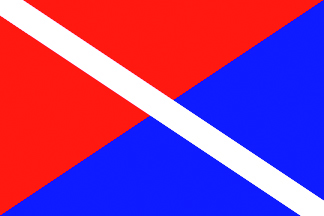
![]() In 1955 I was appointed third mate of the twin screw M.V. Irisbank on what was to be an unforgettable voyage.
In 1955 I was appointed third mate of the twin screw M.V. Irisbank on what was to be an unforgettable voyage.
She was a real old timer, built in 1930, and a war survivor, with twin screws and a decent turn of speed at 14 knots when both engines were working satisfactorily, which was not always the case. I was the proud possessor of a recently obtained Second Mate’s certificate, and this had propelled me up into an elevated status of officer, far removed from the bilge cleaning, paint scraping, and rust chipping four years spent in a Bank Line apprenticeship. I joined the old girl in dry-dock in Birkenhead and she was a typical Bank Line pre-war ship with wood sheathed decks and open rails. They had a certain charm of their own, and the clunking of the steam winches toiling away could be heard at some time in remote ports all over the globe. We were destined to circle the world twice before this voyage was over and I could proceed to sit for a First Mate’s certificate.
Four vessels were ordered from Workman and Clarke (Belfast) Ltd., and all four were a great success, giving an aggregate of 124 years service. It was some record. They sailed uninterrupted right through WW2 and on into the 1960s. The three sister ships were Lossiebank, Taybank, and Tweedbank, with the Lossiebank taking part in the Crete campaign in May 1941. These ships had distinctive lattice type derricks, and steel deck houses abreast of the main mast to house toilet blocks and galley for the Indian crew. It was a feature of Bank line ships which gave out a recognisable profile. A series of 18 twin screw vessels built in 1924/5 called the Inverbank class had been built by Harland and Wolff (Govan) and the survivors plus the Irisbank class ships formed the heart of the post war Bank Line fleet. None of them would win a maritime beauty contest, but they were true ‘gypsies of the oceans’.
The choice of twin diesel engines had consequences good and bad. There was a good turn of speed, and added reliability, but conversely spares and repairs were doubled up. The engineers often struggled at sea when one engine needed new rings or liners, and they dangled the parts from a hoist while the ship rolled. This happened on our trip all too frequently.
Soon, we were on our way lightship to the U.S. Gulf ports for loading. For the company, this ballast leg was a huge cost, but was necessary for the vessels to get on the regular loading berths along the U.S. Gulf Coast. This was the usual Bank Line pattern for the start of a voyage, and only eased when loading rights from Europe eastward to New Caledonia and surrounding destinations started in 1961.
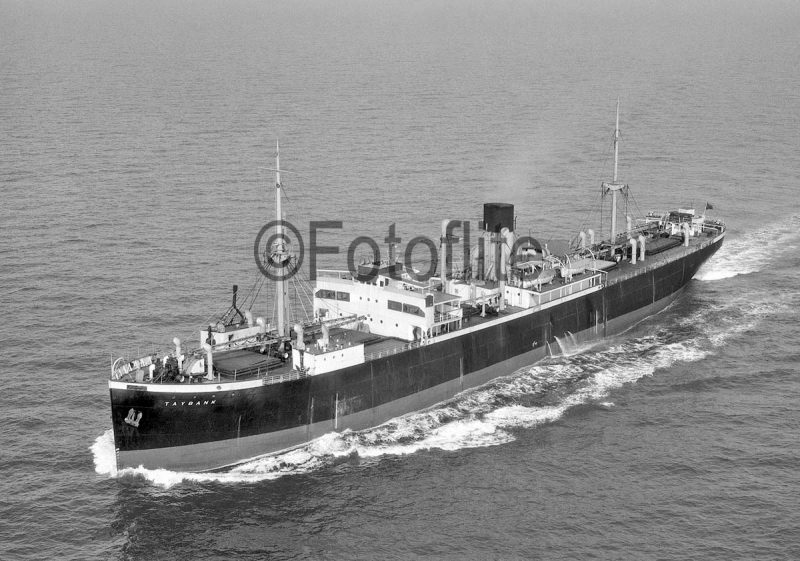
Conditions on board were very basic. No fresh water was available unless hand carried in by the apprentices from the pumps. Cabins had a wooden unit with a fold down basin, hand filled, and which dumped the water into a container in the bottom section for emptying when the basin was tipped up. Included above was a mirror and these units were called ‘compactums’ . It was all primitive and amusing to young lads, game for anything, or so we thought.
Another chore which the apprentices on older vessels undertook was to supervise the water rationing twice daily. Usually a cast iron pump was situated abaft the accommodation and the padlock was removed for an hour morning and night in order for the crew to fill a variety of containers and occasionally slaughter a chicken. The throats would be cut and the chicken dumped in a wicker basket to croak its last breath away.
It soon became clear to me that the Master on this voyage was a strict authoritarian of the old school. He stayed aloof and critical, and was difficult to please, but slowly I learned how to keep out of trouble. Sixty years later I mentally salute him. For one thing he had come through the war at sea, something which we youngsters tended to overlook. Also, he had qualities that I cherish very much today like reliability and dependability. At the time however, I was disappointed to be told firmly that my place on watch was out on the wings of the bridge, i.e. in the open, unless I had a good reason to be inside. This is laughable by today’s standards, but that is how it was. I could only stay in the chartroom or wheelhouse if I was working sights, or needing to alter course, or signal etc. Despite this ego deflating development, life settled into a more or less comfortable routine, and I soon adapted.
We had the Gulf ports to look forward to however and the usual hectic programme of loading. The Superintendents ashore, who ordered the loading pattern, were inclined to sail the ship at nights and to use these hours for positioning the ship in the morning just along the coast. There was a big number of ports that might be involved, from Brownsville, on the border with Mexico, all along to Mobile, the other side of the Mississippi delta. This meant of course that sleep was a problem and was usually taken in catnaps. We duly wended our way through the oil platforms that are dotted around the Gulf of Mexico, and started the loading of bulk sulphur in the lower holds. In Galveston, one of my favourite ports, during time off, we spent some time cruising the bars and stocking up on denim and to my eyes, beautiful cotton shirts and shorts for the tropics. At that time, the main street was very much like those in the cowboy movies, complete with hitching rails, and swing doors.
Loading went smoothly, and we topped off in the crescent city of New Orleans, reached by the long, and carefully piloted Mississippi River, always fascinating to experience. In addition to the big paddle wheelers at that time, there were the long strings of barges, usually being pushed by a distinctive coloured tugboat or two.
The pilots brought with them an air of irreverence and a no nonsense approach which radiated to us youngsters. Their often flamboyant shirts, and ‘can do’ attitude left a lasting impression. It was a huge contrast to the discipline on board.
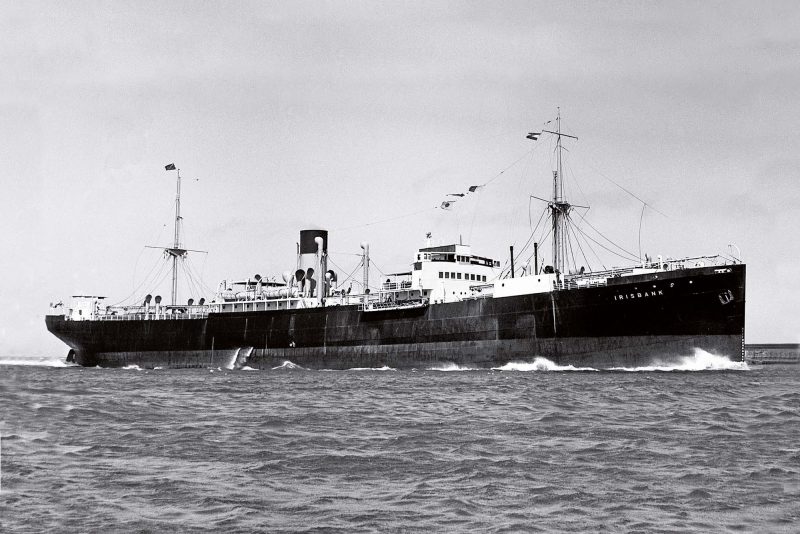
After the canal transit which went smoothly, the long Pacific crossing from Balboa to Auckland in New Zealand gave me a chance to improve my standing with the Master, but it was hard work. Nothing seemed to please. I was sustained by the Second Mate, who had become a friend, and who was a rebel in his own right. We stood together on the bridge for the noon day sights, and when the Master joined us there was always a reverent silence. Anything else was frowned upon. We often got our revenge by ganging up on him when the time came to compare positions, something he must have been aware of. Two against one made him ‘tut tut’, and concede that his calculations might not be accurate.
Engine breakdowns meant that we spent some time steaming along on one engine some days, helm hard over to maintain a reasonably straight course. but the speed fell away as the awkward steering and loss of power took its toll.
A strange event also occurred one night in mid Pacific when I was on the evening watch from 8 to 12 and we were passing one of the many so called uninhabited islands. It was dark, and we were steaming along at the usual 5 miles distant from this small unlit island near the Galapagos islands.
Pacing up and down the bridge wing I saw a small white light ashore, and it became clear it was blinking SOS. I waited and yes, there it was again. I called the Captain up to the bridge and he stood silently looking. Nothing happened for a while, but then the light resumed and he grudgingly acknowledged to me he had seen it, and disappeared into the chartroom to study the sailing directions for that area. We sailed on, and his comments were, “Oh, well, there is a trading schooner that calls here every six months”. Readers might feel critical of this non action, but I have asked myself many times what I might have done in his shoes. No doubt he was weighing up the delay and displeasure in Head Office, coupled with the fact that we only had cumbersome heavy wooden lifeboats to pass through any surf around the place. We didn’t have a large scale chart, if there was one, of such a small island. Nothing could have been attempted until daylight anyway, which meant drifting or steaming up and down until daybreak. It was a difficult call, but I still had that niggling feeling we should have responded.
Soon we passed through the twin islands of Bora Bora in the Society islands, not far from Tahiti. First the peaks lifted out of the ocean, then the water shallowed and turned light blue as we progressed. Pleasure craft were sailing off the shore. It doesn’t sound very exciting, but when there were weeks of nothing but empty ocean all around, any change of scenery is welcome.
After a few weeks on this transit of the Pacific, we finally approached the pilot station off Moreton Island which serves the Queensland port of Brisbane. It had taken us the best part of four weeks. The weather was too rough for the pilot to board and we waited while they signalled furiously with an extremely bright light and which I found very difficult to read due to it being so close and strong. In exasperation, the Master sent below for my pal, the Second Mate, who was roused from his sleep! Ignominy! The signals whizz kid from sea school had struggled and failed to read a signal in time of need. It just added to my feeling of inadequacy which was being relayed to me on an almost daily basis.
We worked our way round the coast, discharging the usual mix of tractors, general cargo, including lamp black, hickory handles, drummed oil and additives, and assorted pallets, together with the bulk cargo. This had to be discharged using shoreside grabs, but on the ships gear. It was common for the sulphur dust to sometimes ignite on these occasions. Sparks from metal brushing on metal often triggered blue flashes which could be spectacular.
Bill Haley and the Comets were at their peak at this time, with ‘Rock around the Clock’ and other hits and we were to see him on trips ashore as he toured the cities in New Zealand and Australia. My memory is of crowded dance halls, an electric atmosphere with the loud beat, and a haze of blue smoke bobbing up and down in unison with the dancers. There were nasty scenes reported as the seats and fittings were flung around by over hysterical and drunken revellers.
Little did we realise we were viewing an iconic band!

Life on board was good, and there was a camaraderie between the deck and engine room officers, not forgetting the Sparkie, or radio officer seconded from the Marconi company. He was a wild card with very independent ideas and a challenging streak which made life interesting, given the stern Master we were under. There were various moments of rebellion – coloured hair, mohican hair cut, and raucous trumpet playing around the ship, all received with equanimity, partly due, I suspect, to the fact that Sparkie was a Marconi employee at the end of the day, and slightly insulated from normal discipline. He was also a strong traditional jazz fan and I recall him arranging tickets to see Louis Armstrong on stage in Sydney. We also celebrated my 21st birthday in port, which at least allowed us to have some celebratory drinks, away from the rather muted atmosphere on board.
Orders came that we were to take a full cargo of grain for India and to sail around to Fremantle in Western Australia to load. Someone back in Head Office decided in their wisdom that they could save money by getting the ships staff to erect the necessary shifting boards. These were a statutory requirement with bulk grain cargoes. This work, normally carried out by shipwrights, involved erecting large wooden partitions to prevent grain from shifting in adverse weather, particularly when rolling heavily. Hence the name. A diagram was produced from somewhere, and the officers and apprentices, aided by the Chinese carpenter spent several days swinging around the holds precariously at sea, finally producing a credible version of the drawings. It was the first time I had done any manual work since signing on in the elevated status of Third Mate and I enjoyed the change.
Arriving in Fremantle though, all hell broke loose. The wharfies who were in cahoots with the shipwrights and in particular their union, took a very dim view of us robbing them of what was their work, and they swiftly condemned our efforts. For good measure, they engineered a detailed survey of our wooden boats, and I remember watching the surveyor going to work on the planking with a pointed tool, finally, triumphantly, springing the planking away from the stem bar. The boat was condemned and as there was no replacement available in Australia we were stuck in Fremantle on a lay up berth until a replacement could be shipped in. The long sandy beach was only 100 yards away across the road and we spent several more or less idyllic weeks there, swimming and playing cricket etc. in the day, and visiting the bars at night. It was tough. Once again, in later years I came to think about the loss to the company, but any sympathy was tempered by the knowledge that the shifting board fiasco ordered by them had been the initial cause.
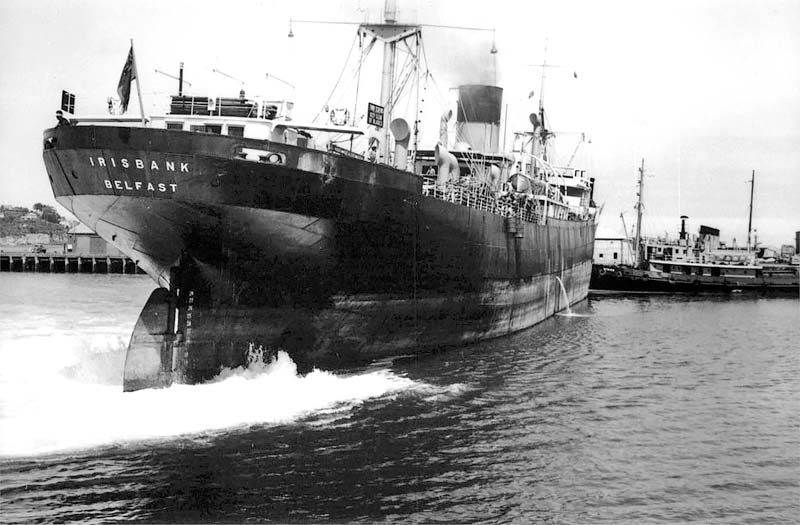
We sailed to India with bulk grain. First port was Visagapatam where I had the satisfaction of leaning over the bridge front after we rang ‘Finished with engines’ to see the hold below opened up and the bulk grain filling the space, right up to the top of the coamings. An amazing sight was the swarm of dock workers who set to. As it was bulk grain, the technique was to bag it there and then, before making up sling loads for swinging ashore. A man with a scoop stood with his back to the open bag held by another, his legs apart, and then frantically scooped away until each bag was quickly filled. Another worker stood ready with needle and thread and quickly secured the top of each bag as it filled. The swarm of ants analogy came to mind watching this, but it was efficient in a labour intensive way.
It sounds a bit mawkish now, but rightly or wrongly, I did feel a sense of pride coupled with satisfaction that we had successfully steered this cargo into their hands, all the way from Australia.
About this time, some of us were into ship visits. A Russian ship astern of us proved to be extremely hospitable. It was the middle of the ‘cold war’ but seafarers generally are not into politics, and they entertained us all royally, with vodka and beer, but in rather bleak surroundings. The messroom where we partied had a huge picture of Lenin, and best of all, a battered piano as the centre piece. It was a very basic, but friendly affair, and we staggered back along the quay, well satisfied.
After Visagapatam, we made the almost inevitable trip up the winding Hooghly river to Calcutta and dry-docking before loading the ubiquitous gunny bags for African ports. They had an almost insatiable demand of bags for exported produce. In the fast flowing river, and in an awkward spot just outside of the lock gates we suffered a loss of air for starting the engines, and made an emergency anchoring, something which didn’t help the Captain and his heart problem! It was a feature of these ships that the air bottle for starting the engines was capable of only a dozen starts before running out. This weakness led to the Master routinely asking pilots to keep the engines ticking over, dead slow, rather than stopping and starting. Not all of them listened or cared.
We discharged along the West African coast, calling at all the ports, sometimes only to discharge a few tons. Most of the ports were served from an anchorage, and so called Kru boats, big and seaworthy, skilfully handled, took our cargo ashore. In Freetown, I had occasion to go ashore with some pals, and I was bowled over by the beauty of all the young topless girls walking unconsciously along often with baskets perched on their head.
The difference in the style and layout of the port cities was very noticeable too, the French towns being the smartest by far in my opinion. Dakar in Senegal being a perfect example. Neat squares with palms, and boulevards as in Metropolitan France. Ditto, Abidjan in the Ivory Coast. For some reason I always felt that Africans speaking fluent French was a bit incongruous, especially as a few miles along the beach, an imaginary line separated Colonial France from Colonial Britain. This is most noticeable at Cotonou in Benin, a few miles from the Nigerian border.
After discharging the last bale of gunny bags in Dakar, Senegal, we received orders for Point Fortin, Trinidad. This meant a lightship voyage of around ten days, and we anchored off ready to load bitumen in drums. Nearby was the famous bitumen lake with its unique gooey surface being worked by lines of mechanical cutters. We also enjoyed the facilities at the Shell Club nearby, which were much appreciated. Sadly, the pool and patio occasionally were trashed by visiting ships crews who were then barred for a period. We were lucky on this visit.
The passage through the Panama Canal was fairly uneventful, and then came the long Pacific journey lasting several weeks, the monotony only punctuated by passing the many remote islands en route. The first of these was nearly always Matu Hiva in the Marquesas, where waterfalls could be seen tumbling down the high ground. Apart from impromptu stops for engine repairs, and some island spotting, it was routine all the way. Some nights, and in favourable atmospheric conditions, the USA radio stations would be heard loud and clear, thousands of miles away. WOAI, San Antonio, Texas, WASB, Nashville, Tennessee, and KOHA, Oklahoma were prominent.
We discharged all around the New Zealand coast, ending up in the very southern port of Bluff, famous for oysters. They were not my taste, but they were immensely popular with the ships officers, washed down of course with suitable quantities of local beer. Leaving Bluff to load in Australia, we rounded Stewart Island at the southern end of New Zealand. We then lost a man overboard. The sea was rough and cold and he was engaged in helping to dump slings of dunnage wood over the side, a common practice then. The rails had been removed and a full sling gently nudged him over the side as the ship rolled slowly. It must have been a slow motion nightmare for him. The next 4 hours were spent looking over the ocean which had angry whitecaps and a heavy swell running. The sea was inhospitable that afternoon.
I chose to climb the mainmast with binoculars to better scan the horizon, and I sat uncomfortably for a long time cramped up and gripping the round truck at the top for safety, but without spotting anything. To make matters worse, the Captain for some reason was reversing the engines occasionally, presumably because they had seen something from the bridge, and this vibrated the top mast violently, whipping it backwards and forwards. I was like the fly on the end of a swatter, but managed to cling on, scared as hell, saved only because the reversal of the engines stopped. No one on the bridge had noticed my predicament. As it got dark it was decided to resume our course, and then just when the search had been called off, and I returned to the bridge, we all spotted flocks of sea birds feeding on something in the water. It was our shipmate. One of our clumsy wooden lifeboats, the motorboat, was prepared and several of us volunteered to go. It’s the sort of thing you do when young and without a thought. After some difficulty with an engine room discharge flooding the boat as it was lowered, we set off in quite heavy weather with my pal, the Second Mate, at the helm. He did a great job, skilfully preventing the boat from flooding or broaching – not an easy task. We had rushed to get in the boat, and the rather perilous situation dawned on me as we cast off It was my first experience of a smallish boat in the open ocean and the Irisbank disappeared completely when we were in the troughs of the waves. I started singing my head off, later attributed to nerves by folk who know about these situations. When we got to the body, it was relatively easy to roll the poor young seaman straight into the boat, aided by the fact that we were low in the water and partially swamped. First we had to use oars to beat off the insistent birds feeding on his face. They had pecked out his cheeks. I helped roll his body onto the thwart, and was shocked to see the condition with all the teeth exposed, and even eyes dislodged.
On return to the ship, things got worse. The ship was rolling heavily, and although we managed to engage the lifting hooks, we swung wildly out and then crashed back hitting the hull, severely damaging our planking. The body came close to shooting out of the boat, but worse than that I had trapped my fingers badly in the lifting block when hooking on, and as a result of the lifting and crashing around. I must have been screaming, because someone with an axe started to swing at the rope falls to release my hand, when suddenly it was freed by the action of a passing wave, lifting the boat high and causing the ropes to slacken. Out came my crushed fingers, and we continued up the ship’s side, relieved to be free of the turmoil. Once up in the davits I was shocked to see the boat side completely stove in and the copper buoyancy tanks, hanging out. These are normally stowed along the sides below the side thwarts. The boat later needed replacement, our second one on this trip.
Glad to be safely back, we then got orders to apply artificial respiration to the poor seaman! It was long past the stage where any chance of life remained, but orders are orders. Eventually our Asian crew prepared the body for a burial at sea, which they were to carry out. This also turned out to be a sad fiasco, as the plan was to lower the body, now in a canvas shroud, down the ships side on staging with attendant seamen either end. Due to the adverse weather, the staging got halfway down when a huge wave swept along the side of the ship and the body disappeared into the wake. As it was now dark, we resumed the voyage, leaving matters to fortune. The canvas shroud was weighted, so would have found a resting place at the bottom of the ocean. A really sad affair, and we literally packed up his belongings for return to relatives in Calcutta. A lifebelt later washed up on the shore of South Island, and the finders, curious, contacted the owners back in London.
Arriving in Australia, we had the good fortune to be in Melbourne for the November 1956 Olympics, and in our usual cheeky way, managed to gain entry for a day without paying. Also in port was the royal yacht Britannia and some of us wandered along the quay to admire the glossy blue hull and beautiful white superstructure. She was a handsome ship with a classic profile. I was to see her again in different locations before she and I both went into retirement.
Next stop was Chittagong loading jute bales here and at Chalna in the Sundarbans, one of the largest Mangrove forests in the world. We were then off to a long list of ports in East, South, and West Africa. When we had arrived off Chittagong harbour on the Karnaphuli river we had struck a sand bank during my watch. The action appeared to me to be in slow motion but we were at full speed on a clear day around noon. Looking ahead, the water suddenly appeared to be rippling ahead in a strange way. Alarmed, I had switched on the old paper sounder which clacked away as the stylus whizzed round and round. While I watched mesmerised almost, the line marking the bottom of the sea came up steeply towards us, and I rushed back into the wheelhouse, just in time to witness us thumping the bank beneath the waves. We heeled right over, and a wave created by the collision swept up and over the boat deck, with water swishing down to the engine room via the skylights which were open. This triggered a frantic call from the engineers asking what the hell is going on! In the meantime, I had rung down to stop the engines and sheered off to port, calling the Master to the bridge.
Protest was noted when we berthed, and it later transpired to my relief that the buoy supposedly marking the shoal had been dragged away by a recent hurricane to a false position. No serious damage had been done, but we were not to know this until dry-docking later in the voyage.
Some happy days were spent midway through our coastal hopping around Africa when we arrived in Durban to discharge some Far Eastern goods transhipped from Colombo. It was a rare taste of a modern city and we made full use of the short port stay. There is a memory of the port workers too, dancing and singing their way ashore after a shift, all bedecked out in Japanese silks and fancy shoes gleaned from the holds, and worn to evade the tough guards on the port gate.
This voyage was near an end. We learned that we would be flown home from Bathurst in West Africa and when the day duly arrived, we boarded a Viking type aircraft for the flight home to Blackbush airport. The replacement crew had flown out on the same chartered plane, but we were destined not to meet, as we passed to and from the airport. The runway was military style, with metal mesh sheets laid on the grass and it was my first flight. I recall there was some difficulty with the amount of luggage we had accumulated over the two years away. On board the Viking type aircraft, there was a huge beam running across the cabin, a strange feature on this model. I soon noticed sweating hands after take off, which the stewardesses explained were the result of nerves. The pilots chose to buzz the ship after take off and we swooped down in a stomach churning dive, which didn’t help things much. We then set off to follow the African coast northwards. I did notice the pilots up front looking ahead through binoculars when the cockpit door was open. In those days this journey had to be broken halfway and we all spent a glorious night in the Rock Hotel in Gibraltar, wallowing in hot water baths, and enjoying the delights of the dining room.
There was a further refuelling stop at Biarritz in France in the morning, and then we arrived safely at Blackbush as night was falling.
All the lights were twinkling on approach and as the coach swept us up to London we passed all the picturesque pubs with fairy lights and welcoming forecourts. It was pure magic to my mind, and the contrast from our previous two years of primitive living could not be greater.

I was a bit overwhelmed emotionally, but already becoming wistful for my old life on board!
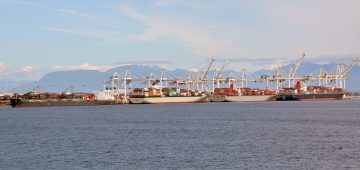


Comments
Sorry, comments are closed for this item